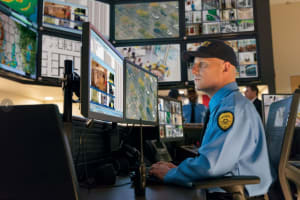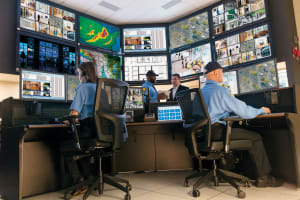Elevator Security and Control: Everything You Need to Know

Hundreds of millions of elevator rides occur every single day across the world. Elevators are critical to how we work, how we live, and how we navigate throughout multi-story buildings as we perform daily tasks. With elevators being critical to so many different aspects of our lives, the importance of ensuring that elevators are as secure as possible is at an all-time high.
Although elevator security is growing in importance, it continues to be a critical challenge for the commercial real estate industry, including high-rise office buildings, hotels, and apartments. Leaving elevators unsecured means exposing occupants and valuable assets to potential security threats, ranging from unauthorized access and vandalism to more severe risks such as theft, sabotage, or even acts of terrorism.
Robust elevator security is also essential for maintaining the overall safety and integrity of the building infrastructure. In addition to using traditional surveillance technology, building owners and managers should deploy elevator control systems to ensure access is only available to authorized residents, employees, or visitors.
Continue reading to uncover the benefits of elevators and discover how building owners can seamlessly integrate them into existing security solutions.
What are the Types of Elevator Control?
There’s a world of difference between traditional elevator control systems and IoT elevators from a security perspective. Here’s a quick breakdown of where these two models differ:
Traditional Elevators
Traditional elevator control relies on floor control and floor tracking mechanisms, where proximity card readers and relay logic play a pivotal role in granting access to specific floors. Floor control establishes restrictions on individual access to certain floors during designated times, while floor tracking meticulously records the chosen floors by individuals. However, these solutions are hardware based and lack to the sophistication of Internet of Things (IoT) elevator control, which makes them less efficient and more labor intensive then modern smart solutions.
Destination Dispatch Integration
Modern, IoT elevators employ destination dispatch integration. This system directs individuals to a specific elevator cab based on their desired floor destination. Authentication occurs at a kiosk or terminal, where the individual is authorized and directed to the appropriate cab. This integration minimizes energy consumption, optimizes passenger traffic, and enhances overall building efficiency.
What is an IoT Elevator?
An IoT elevator is an elevator equipped with advanced access control technology to control building access and monitor visitors. These elevators facilitate movement between floors and ensure that only authorized individuals can access specific levels at designated times. This is achieved through diverse credential technologies, including proximity cards, smart cards, mobile credentials, QR codes, or PIN numbers.
Beyond security, these elevators also generate valuable historical data, offering insights into individual behavior and overall building utilization. This data is instrumental for security audits, informed decision-making, and optimizing building operations.
What Security Systems are Used for Elevator Access Control?
Robust elevator security solutions consist of multiple components that regulate access control. These include:
Credentials
IoT elevators are credential-independent, allowing the use of various authentication technologies, including proximity cards, smart cards, or mobile credentials. Mobile credentials, in particular, help promote health by eliminating high-touch surfaces that harbor bacteria. In addition, they offer increased security, added convenience, reduced costs, and limited device contact.
Smart Access Technology
Utilizing mobile credentials, elevators allow smartphones to be used for authentication, offering hands-free access control. The use of smartphone-based credentials can be part of a planned migration, making it compatible with existing infrastructure.
Visitor Management System
Visitor management systems like OnGuard Visitor can integrate with IoT elevator solutions to ensure a streamlined experience for visitors. This comprehensive solution includes sensors, occupancy tracking, entrance control, and event management features. The event management capabilities support contact tracing and provide detailed access event reports, while innovative sensors and video surveillance contribute to maintaining safe occupancy levels and enhancing situational awareness.
Access Control
Elevators, in conjunction with seamlessly integrated video surveillance and access control systems, can truly elevate building security. Whether you're overseeing a corporate campus or or mixed-use structure, access control systems offer dynamic support. Access control systems that can be tailored to specific building needs also yield stronger results.
How Does Elevator Control Work?
Elevators leverage advanced technologies for improved security and access control. Often, these elevators feature touchless buttons that are activated with a smartphone credential, prioritizing user convenience and hygiene.
With IoT elevators, destination dispatch methods streamline the authentication process. Tenants, employees, or visitors check in at a kiosk, and the system directs them to a specific elevator cab, optimizing the journey to their desired floor. Through the integration of elevator access control with IoT technologies, these elevators ensure efficient and secure vertical transportation.
Benefits of Investing in Elevator Control
Beyond traditional transportation, elevator control promises enhanced security and efficiency. Benefits include:
Managing Visitor Access
Elevators facilitate efficient management of visitor access. By streamlining the entry process for visitors, the system ensures that unexpected guests are prevented from unauthorized access. This not only enhances overall security but also creates a more convenient and predictable experience for visitors, guiding them seamlessly to their intended destinations.
Remote Control
Remote control capabilities in elevators provide heightened flexibility and centralized control, bolstering overall security. This allows for efficient monitoring and management, empowering administrators to adapt to dynamic building needs while ensuring a secure and responsive elevator system.
Live Monitoring
Live monitoring in elevators enables real-time tracking of elevator usage, significantly enhancing security measures. This dynamic capability ensures immediate responsiveness to any anomalies or security concerns, optimizing the overall safety and efficiency of the elevator system.
Touchless Access Control
Physical access cards can be lost or stolen, which inconveniences occupants and introduces security risks. Complete elevator control systems used in conjunction with turnstiles, including touchless features like facial recognition and thermal screening eliminate these issues, reducing physical touchpoints for enhanced safety and security. This not only prioritizes the well-being of occupants but also helps foster a seamless and hygienic environment.
Providing Historical Data
Elevator security solutions collect valuable historical data. Through the access control system and advanced video analytics, these solutions offer a comprehensive view of individuals' behavior and overall building utilization. This information not only facilitates strategic decision-making but also contributes to continuous improvement in physical security protocols.
Key Considerations for Elevator Security Systems
When evaluating elevator solutions for your property, consider whether each system will be able to meet your current and future needs. Assess considerations such as:
Scalability
IoT-connected access control systems should be designed for seamless scalability, ensuring they can adeptly meet the diverse needs of buildings. By providing a unified system for multiple elevators, they offer a flexible solution that can grow with evolving infrastructure requirements.
Elevator Integrations
Elevators need to seamlessly integrate with third-party systems, encompassing access control, video management, visitor management, alarm panels, and more. This ensures a streamlined operational environment and offers a cost-effective pathway for upgrades.
Intuitive Systems
Setting up elevator controls should be a user-friendly process, demanding minimal professional training for configuring access permissions and usage. A hassle-free implementation helps promote accessibility for users across various skill levels.
Use Elevator Security Integrations with LenelS2 to Secure Your Commercial Buildings
LenelS2 has been a pioneer in elevator control in commercial building access control for more than 25 years. We developed one of the first access control systems offering full software integration with destination dispatch technology over 15 years ago. We’ve continued to innovate with smart technology, keeping our customers protected while reducing friction in the security process.
All LenelS2 solutions offer elevator control and integrations with all leading destination dispatch systems. In addition, our BlueDiamond technology enables NFC credentials on smartphones and is compatible with all elevator security solutions.
Interested in learning more about how we can help you keep your building and its occupants safe with smart elevator technology? Get in touch today.




